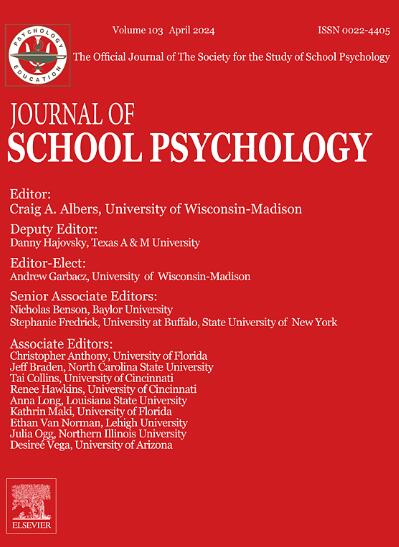使用朴素贝叶斯方法识别基于多个来源的学术风险:概念复制。
IF 4.1
1区 心理学
Q1 PSYCHOLOGY, SOCIAL
引用次数: 0
摘要
本研究的目的是对Pendergast等人(2018)的研究进行概念复制,该研究检验了nomogram程序(也称为朴素贝叶斯方法)的诊断准确性。具体的朴素贝叶斯方法结合了学术和社会情感和行为(SEB)筛选数据来预测学生在州年终成就测试中的表现。研究数据是在中西部一个大型郊区学区收集的,涉及两个学年和19所小学。参与者包括3-5年级的5753名学生。学业筛选数据包括aimswebPlus阅读和数学综合分数。SEB筛查数据包括来自社会、学术和情绪行为风险筛查的学业行为子量表得分。标准分数来自密苏里州评估计划(MAP)的英语语言艺术和数学测试。将每个个体筛选者的表现与朴素贝叶斯方法进行比较,朴素贝叶斯方法综合了测试前概率信息(即,从上一年MAP测试分数得出的全区基本风险率)、学术筛选分数和SEB筛选分数。然后使用阈值模型(VanDerHeyden, 2013)评估测试后概率分数,以确定样本中可以根据排除或排除干预而区分的学生与未区分的学生的百分比(根据需要进行额外评估以确定风险状态)。结果表明,朴素贝叶斯方法倾向于与个人aimswebPlus测量方法相似,在预测熟练表现时,所有方法都产生了很大比例(65%-87%)的未分化学生。总的来说,结果表明我们可能无法复制原始研究的结果。讨论了研究的局限性和未来的研究方向。本文章由计算机程序翻译,如有差异,请以英文原文为准。
Using a naive Bayesian approach to identify academic risk based on multiple sources: A conceptual replication
The purpose of this study was to conduct a conceptual replication of Pendergast et al.'s (2018) study that examined the diagnostic accuracy of a nomogram procedure, also known as a naive Bayesian approach. The specific naive Bayesian approach combined academic and social-emotional and behavioral (SEB) screening data to predict student performance on a state end-of-year achievement test. Study data were collected in a large suburban school district in the Midwest across 2 school years and 19 elementary schools. Participants included 5753 students in Grades 3–5. Academic screening data included aimswebPlus reading and math composite scores. SEB screening data included Academic Behavior subscale scores from the Social, Academic, and Emotional Behavior Risk Screener. Criterion scores were derived from the Missouri Assessment Program (MAP) tests of English Language Arts and Mathematics. The performance of each individual screener was compared to the naive Bayesian approach that integrated pre-test probability information (i.e., district-wide base rates of risk derived from prior year MAP test scores), academic screening scores, and SEB screening scores. Post-test probability scores were then evaluated using a threshold model (VanDerHeyden, 2013) to determine the percentage of students within the sample that could be differentiated in terms of ruling in or ruling out intervention versus those who remained undifferentiated (as indicated by the need for additional assessment to determine risk status). Results indicated that the naive Bayesian approach tended to perform similarly to individual aimswebPlus measures, with all approaches yielding a large percentage (65%–87%) of undifferentiated students when predicting proficient performance. Overall, the results indicated that we likely failed to replicate the findings of the original study. Limitations and future directions for research are discussed.
求助全文
通过发布文献求助,成功后即可免费获取论文全文。
去求助
来源期刊

Journal of School Psychology
PSYCHOLOGY, EDUCATIONAL-
CiteScore
6.70
自引率
8.00%
发文量
71
期刊介绍:
The Journal of School Psychology publishes original empirical articles and critical reviews of the literature on research and practices relevant to psychological and behavioral processes in school settings. JSP presents research on intervention mechanisms and approaches; schooling effects on the development of social, cognitive, mental-health, and achievement-related outcomes; assessment; and consultation. Submissions from a variety of disciplines are encouraged. All manuscripts are read by the Editor and one or more editorial consultants with the intent of providing appropriate and constructive written reviews.
 求助内容:
求助内容: 应助结果提醒方式:
应助结果提醒方式:


